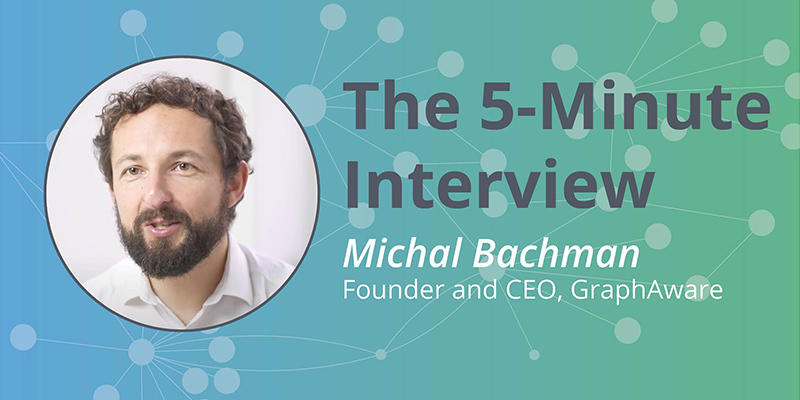Leading the Global Growth of Graphs: The 5-Minute Interview with GraphAware

Product Marketing Manager, Neo4j
4 min read

“Every organization in this world will have graphs, and we want to be the most trusted partner on everybody’s graph journey. Our mission is to help people adopt graph technologies by sharing expertise and building tools that make it very easy,” said Michal Bachman, CEO of GraphAware.
In this week’s 5-minute interview, we spoke to Michal Bachman, CEO of GraphAware, the winner of the Graphie for International Expansion Partner of the Year, about the global expansion of graphs.
Tell us a little about GraphAware
GraphAware is a company that believes that in ten years graphs will truly be everywhere in the graph technology sense. So every organization in this world will have graphs and we want to be the most trusted partner on everybody’s graph journey. Our mission is to help people adopt graph technologies by sharing expertise and building tools that make it very easy.
What is the strength of taking a global approach to graphs?
The fact that our business is global definitely brings a unique set of challenges with it, but also opportunities. We definitely have access to global talent by being global. In fact, some of our best colleagues have been hired over social media and it took years before we actually met them face to face.
It also means we can serve our customers globally. Threats, whether they are criminal organizations or pandemics, naturally span across borders and you need to keep up with them to keep your countries and communities safe. Compliance issues have international elements to them and researchers need to collaborate across countries and continents. So I’m very happy that we are an international organization that is uniquely positioned to help all our customers.
How has GraphAware changed in 2020?
It has really been an interesting year. We have learned two things. One is that for us and our customers, that remote working is not only possible but actually beneficial in many cases. For our customers, the local vendor around the corner is as good as somebody like us who may be halfway across the planet, so it makes the choice much bigger for our customers but it also makes the market much bigger for us.
The second thing we learned is that we were able to learn to work across time zones to our benefit. We have some important customers in Australia while most of us are located in Europe, and we’ve learned to collaborate in such a way that there’s constant progress all the time. While we are sleeping, the customer is reviewing and giving us feedback and then when we wake up in the morning we can start producing more great stuff. So really this has been 24/7 progress and it’s been amazing to see that.
How have you been taking advantage of machine learning and graphs?
For a long time we’ve been talking about the combined power of machine learning and graphs. One implementation that we’ve recently finished that I’m particularly excited about is implementing a knowledge graph for governance instruments for a heavily regulated government organization, by ingesting data, mostly unstructured free text from different sources, be it publicly available sources such as legislation or internal documents such as standard operating procedures and guidelines.
We were able to build a knowledge graph of rules and obligations that are placed upon the organization. It made it very, very easy to detect and analyze what happens if a piece of legislation changes and what impact it has on internal processes and other kinds of documentation. It helped us detect missing obligations that aren’t implemented in internal procedures.
For example, if somebody who’s responsible for a guideline is no longer in the organization, we can flag it and suggest who else should be responsible. So this simplification of governance by using natural language processing to understand legislation and related documents has been super powerful and a very, very exciting implementation.
What is next for GraphAware?
We’re going full steam ahead with Hume, our graph-powered insights engine.
I cannot reveal too much but what I can say is that we have seen how much easier Hume makes it for people to adopt graphs – to pick up Neo4j and start working with it. So we’re going to be taking concrete steps to make it even easier for people to pick up Hume – and therefore Neo4j – and start leveraging the power of graphs and thereby executing on our mission of enabling graph adoption.
Want to share about your Neo4j project in a future 5-Minute Interview? Drop us a line at content@neo4j.com
Get this white paper and discover The Top 10 Use Cases of Graph Database Technology.








